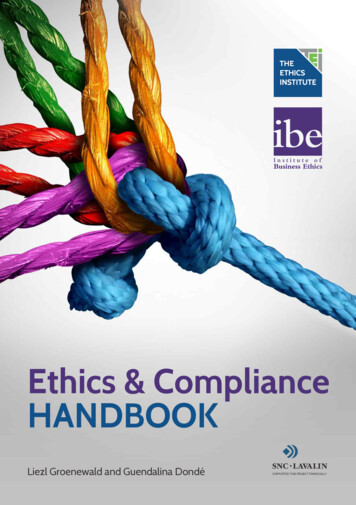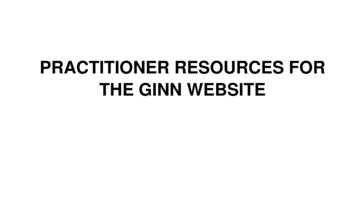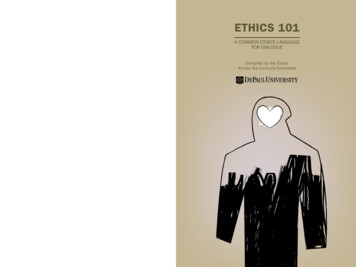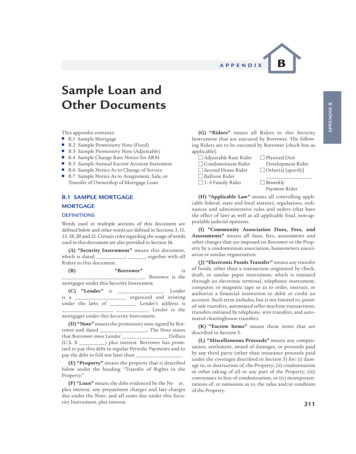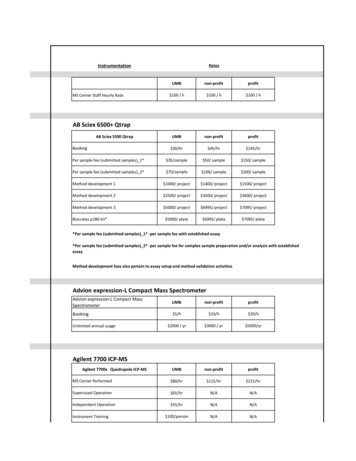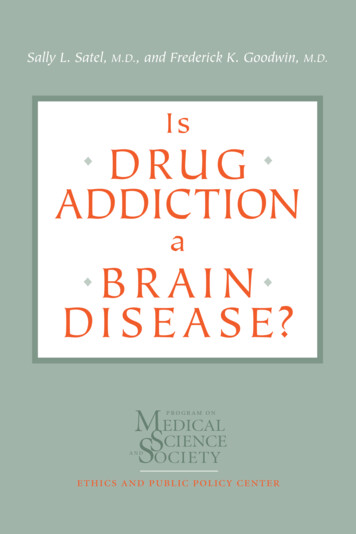
Transcription
Sally L. Satel, M.D., and Frederick K. Goodwin, M.D.IsDRUGADDICTIONaB R AI NDI S E A S E?program onEDICALCIENCEOCIETYSSandethics and public policy center
Is DrugAddiction aBrain Disease?Sally L. Satel, M.D.Frederick K. Goodwin, M.D.p r o g r am o nEDICALCIENCEOCIETYSSandethics and public policy centerwashington, d.c.
SALLY L. SATEL, M.D., is a practicing psychiatrist, a lecturer atYale University School of Medicine, and a senior associate inthe Ethics and Public Policy Center’s Program on MedicalScience and Society. Dr. Satel’s articles have appeared innumerous medical journals and in such periodicals as the WallStreet Journal, The New Republic, The Public Interest, and TheWomen’s Quarterly. Her clinical and research expertise is inaddiction medicine, and she has written extensively aboutdrug treatment. She is also particularly interested in theproblems of politicized science and the intrusion of politicalcorrectness into medicine and research. Dr. Satel holds an M.S.from the University of Chicago and an M.D. from BrownUniversity.FREDERICK K. GOODWIN, M.D., director of the Program onMedical Science and Society of the Ethics and Public PolicyCenter, is a Research Professor of Psychiatry at the GeorgeWashington University and director of the university’s Psychopharmacology Research Center. He is an internationallyrecognized authority on the research and treatment of majordepression and manic-depressive illness, and he previouslyserved as director of the National Institute of Mental Health(NIMH). Dr. Goodwin hosts the National Public Radio program“Infinite Mind.” He is the author of more than four hundredpublications. Manic-Depressive Illness, which he co-wrote withKay R. Jamison, Ph.D., was the first psychiatric text to benamed Best Medical Book by the Association of AmericanPublishers. He received his M.D. from St. Louis University.
ContentsPreface vIS DRUG ADDICTION A BRAIN DISEASE? 1What Does “Brain Disease” Mean? 3Clinical Features of Addiction, 5Interrupting the Addictive Process, 7“Chronic and Relapsing” Brain Disease? 9Drug Cures for Drug Addiction? 12The Methadone Success, 13The Residential Advantage, 15Needed: Enlightened Coercion 16Compulsory Residential Treatment, 17Drug Courts: Treatment and Sanctions, 18Entitlements as Shapers of Behavior, 20Concluding Observations, 21Notes 23
Program on Medical Science and SocietyEthics and Public Policy Center1015 Fifteenth Street NW, #900 Washington, D.C. 20005202-682-1200 fax 202-408-0632www.eppc.org e-mail ethics@eppc.orgThe moral issues that shape foreign and domestic policy are central tothe work of the Ethics and Public Policy Center. The Center is a nonprofit institution established in 1976 to clarify and reinforce the role ofthe Judeo-Christian moral tradition in the American public policy debate.Its activities include research, writing, publications, and conferences.Current programs include Catholic Studies, Evangelical Studies, JewishStudies, studies in religion and foreign policy, the Project on the Judiciary, the Program on Medical Science and Society, and the Marriage LawProject. The Center’s president is Elliott Abrams.ISBN 0-89633-189-XCopyright 1998 by the Ethics and Public Policy Center.Printed in the United States of America. All rights reserved.
PrefaceDramatic advances in the neurosciences are creating the ability topredict and alter human behavior in ways unimaginable only afew years ago. The pace of these developments has outdistanced notonly public understanding but also the measured consideration of physicians, ethicists, philosophers, theologians, and scientists themselves.The Ethics and Public Policy Center’s Program on Medical Scienceand Society addresses the unique challenges that biomedicine presentsfor society today. Under the direction of Frederick K. Goodwin, M.D.,the program works in two directions: it seeks to improve public understanding of biomedical research, and it seeks to make physicians andscientists more aware of the social, cultural, political, and psychologicalcontexts of biomedicine and its effects on both society and the individual. Various projects focus on: improving public understanding by strengthening public biomedical literacy and combating “junk science”/anti-science; promoting enlightened public policy on issues relating to health,health care, and biomedical research; and illuminating the implications of contemporary developments in thebrain sciences for the ethical, religious, and philosophical underpinnings of Western society.Is Drug Addiction a Brain Disease? is the first in a series of occasional papers from the Program on Medical Science and Society. Amongthe questions raised by this essay is whether the traditional concept offree will can be sustained in the face of new knowledge about biological and environmental forces that shape human behavior.
Is Drug Addiction aBrain Disease?Sally L. Satel, M.D., and Frederick K. Goodwin, M.D.More than 100 substance-abuse experts gathered in Chantilly,Virginia, in November 1995, for a meeting called by thegovernment’s top research agency on drug abuse. A majortopic was whether the agency, the National Institute on Drug Abuse(NIDA), which is part of the National Institutes of Health, should declare drug addiction a disease of the brain. The experts—academics,public-health workers, state officials, and others—said yes, overwhelmingly.1At the time the answer was controversial, but since then, the notionof addiction as a brain disease has become widespread, thanks in largemeasure to a full-blown public-education campaign by NIDA. Waged ineditorial boardrooms, town-hall gatherings, and Capitol Hill briefingsand hearings, the campaign reached its climax in spring 1998 whenmedia personality Bill Moyers catapulted the brain-disease concept intomillions of living rooms with his five-part television special. Using imaging technology, Moyers showed viewers eye-catching pictures of addicts’ brains under PET scan.2 The cocaine-damaged parts of the brainwere “lit up”—an “image of desire,” one researcher called it.Dramatic visuals are seductive and lend scientific credibility to NIDA’sposition, but politicians—and in particular President Clinton’s drug czar,General Barry McCaffrey, who has begun reciting the brain-disease rhetoric—should resist this medicalized portrait for at least two reasons. First,it appears to reduce a complex human activity to a slice of damagedbrain tissue. Second, and more important, it vastly underplays the reality that much of addictive behavior is voluntary.
w2wThe idea of a “no-fault” disease did not originate at NIDA. For the lastdecade or so it has been vigorously promoted by mental-health advocates working to transform the public’s understanding of severe mentalillness. Until the early 1980s, remnants of the psychiatric profession andmuch of the public were still inclined to blame parents for their children’sserious mental problems. Then accumulated neuroscientific discoveriesbegan to show, irrefutably, that schizophrenia was marked by measurable abnormalities of brain structure and function. Diseases like schizophrenia and manic-depressive illness were products of a defective brain,not bad parenting.The mental-health movement has drawn momentum from the twentyyear-old National Alliance for the Mentally Ill (NAMI), the nation’s largest grassroots advocacy organization for people with severe psychiatricdisorders and their families. NAMI has mounted a vigorous anti-stigmacampaign—slogan: mental illnesses are brain diseases—that has soughtto capture public attention through television exposure, publicized opinion polls and surveys, star-studded fund-raisers, and frequent congressional testimony. Its success can be seen in the increasing media coverageof severe mental illness, sympathetic made-for-TV specials about thementally ill, and the widespread assumption, usually explicitly stated byreporters, that these conditions have a biological origin.While some of those experts who met in Chantilly would say thatemphasizing the role of will, or choice, is just an excuse to criminalizeaddiction, the experience of actually treating addicts suggests that suchan orientation provides grounds for therapeutic optimism. It means thatthe addict is capable of self-control—a much more encouraging conclusion than one could ever draw from a brain-bound, involuntary modelof addiction.The brain-disease model leads us down a narrow clinical path. Sinceit implies that addicts cannot stop using drugs until their brain chemistry is back to normal, it over-emphasizes the value of pharmaceuticalintervention. At the same time, because the model also says that addiction is a “chronic and relapsing” condition, it diverts attention from trulypromising behavioral therapies that challenge the inevitability of relapse by holding patients accountable for their choices.Getting a purchase on the true nature of addiction is difficult. Eventhe definition is elusive. For example, addiction can be defined by pathological state (as a brain disease if affected neurons are examined); by“cure” (as a spiritual disease if vanquished through religious conver-
w3wsion); or by psychodynamics (as a matter of voluntary behavior if addicts are given incentives that successfully shape their actions). Yet whenclinicians, scientists, and policymakers are confronted by such definitional choices, it makes the most sense to settle on the one with thegreatest clinical utility. In what follows, therefore, I will argue the virtues of thinking about addiction as a primary, though modifiable, behavioral phenomenon, rather than simply as a brain disease. That is,addiction is a function of a person, rather than simply a physical state.WHAT DOES “BRAIN DISEASE” MEAN?An NIDA article entitled “Addiction Is a Brain Disease, and It Matters,”published in October 1997 in the prestigious journal Science, summarizes the evidence that long-term exposure to drugs produces addiction—that is, the compulsion to take drugs—by eliciting changes inspecific neurons in the central nervous system. Because these changesare presumed to be irreversible, the addict is perpetually at risk forrelapse. The article states:Virtually all drugs of abuse have common effects, either directlyor indirectly, on a single pathway deep within the brain. Activation of this pathway [the mesolimbic reward system] appears tobe a common element in what keeps drug users taking drugs. . . .The addicted brain is distinctly different from the non-addictedbrain, as manifested by changes in metabolic activity, receptoravailability, gene expression and responsiveness to environmental cues. . . . That addiction is tied to changes in brain structureand function is what makes it, fundamentally, a brain disease.3Psychiatrist and molecular biologist Steven Hyman, now director ofthe National Institute of Mental Health, puts the biology in a larger,evolutionary context. “Adaptive emotional circuits make brains vulnerable to drug addiction,” he says, “because certain addictive drugs mimicor enhance the actions of neurotransmitters used by those circuits.”4 Bythe time drugs and alcohol have become objects of intense desire,Hyman’s research suggests, they’ve commandeered key motivationalcircuits away from normal human pleasures, like sex and eating. On acellular level, bombardment by drugs and alcohol produces chronicadaptations in the neurons of the key circuits leading to dependence, astate in which the brain “demands” that the addict get high.
w4wThis is a distinctly different understanding of disease than that promoted by Alcoholics Anonymous, the institution most responsible forpopularizing the disease concept of addiction. In AA, disease is employed as a metaphor for loss of control. Thus members might say, “I amunable to drink or take drugs because I have a disease that leads me tolose control when I do.” And even though AA assumes that the inabilityto stop drinking once started is biologically driven, it does not allow thisto overshadow its central belief that addiction is a symptom of a spiritual defect. The goal is sobriety through personal growth and the practice of honesty and humility.The brain-disease advocates are operating in an entirely differentframe of reference. Within it they have stipulated that “addiction” meanscompulsive drug-taking driven by drug-induced brain changes. Theyassume a correlation between drug-taking behavior and PET scan appearance, though such a correlation has yet to be clearly demonstrated(see note 2), and they speculate, on the basis of preliminary evidence,that subtle changes persist for years. The assumption seems to be thatthe neuroscience of addiction will give rise to pharmaceutical remedies.But to date, the search for a cocaine medication has come up empty.And the disposition to use drugs commonly persists among heroin addicts even after treatment with the best medication for normalizing thecompulsion for heroin—methadone. That is because methadone doesnot, cannot, remedy the underlying anguish for which drugs like heroinand cocaine are the desperate remedy.A Time magazine article entitled: “Addiction: How We Get Hooked”(May 5, 1997) asked: “Why do some people fall so easily into the thrallof alcohol, cocaine, nicotine and other addictive substances . . . ?” Theanswer, it said, “may be simpler than anyone dared imagine”: dopamine, “the master molecule of addiction. . . . As scientists learn moreabout how dopamine works, the evidence suggests that we may befighting the wrong battle [in the war on drugs].” Among the personsquoted is Nora Volkow, a PET expert at Brookhaven Laboratories, whosays, “Addiction . . . is a disorder of the brain no different from otherforms of mental illness.” That new insight, Time intones, may be the“most important contribution” of the dopamine hypothesis to the fightagainst drugs.Given the exclusive biological slant and naive enthusiasm of the Timearticle, one is not surprised at its omission of an established fact ofenormous clinical relevance: that the course of addictive behavior can
w5wbe influenced by the very consequences of the drug-taking itself. Whenthe addict reacts to adverse consequences of drug use—economic, health,legal, and personal—by eventually quitting drugs, reducing use, changing his pattern of use, or getting help, he does so voluntarily. Ratherthan being the inevitable, involuntary product of a diseased brain, theseactions represent the essence of voluntariness. The addict’s behaviorcan be modified by knowledge of the consequences.5 Involuntary behavior cannot.Clinical Features of AddictionAddiction as a term does not exist in the formal medical lexicon, butdrug addiction is generally equated with “drug dependence.” In theAmerican Psychiatric Association’s Diagnostic and Statistical DisordersHandbook (fourth ed.), dependence denotes the persistent, compulsive, time-consuming use of a substance despite harmful consequencesand often despite an expressed desire not to use it. Most dependentusers develop tolerance—they must keep increasing doses to achieve adesired effect. They experience withdrawal symptoms and intense craving when the substance is stopped abruptly, followed by relief whenuse is resumed.It is common for heroin-dependent persons to lose the ability to feeleuphoric from the drug, yet continue to seek it solely to keep fromgoing into withdrawal (“getting sick”). Withdrawal from heroin (andother opiate drugs including Demerol, morphine, Percocet, and codeine)or from alcohol, but not from cocaine, causes a predictable pattern ofphysical symptoms. Recall Jack Lemmon in the movie Days of Wine andRoses, sweating, anxious, his body wracked with tremors, desperate foralcohol after running out of whiskey. Or Frank Sinatra in Man With theGolden Arm, the heroin addict suffering painful muscle cramps andpowerful cravings for heroin after his last fix wears off.Unlike heroin and alcohol, cocaine does not produce florid physicalwithdrawal symptoms. The heavy cocaine addict typically uses the drug(by inhalation or injection) in a driven, repetitive manner for twentyfour to seventy-two hours straight. Cocaine wears off very quickly, andas it fades the yearning for more is overpowering. Each fresh hit quellsthe intense craving. The process winds down when the addict becomestoo exhausted, runs out of money, or becomes too paranoid, a potentialeffect of cocaine and other stimulants, such as methamphetamine. Hethen “crashes” into a phase of agitated depression and hunger, followed
w6wby sleep for twelve to thirty-six hours. Within hours to days after awakening he experiences powerful urges to use, and the cycle resumes.It is almost impossible for a regular user in the midst of a cocainebinge or experiencing the withdrawal of heroin to stop using the drugsif they are available. He is presumably in the “brain disease” state, whenuse is most compulsive, neuronal disruption most intense. True, purposeful behavior can occur even in this state—for example, the attempt,sometimes violent, to get money or drugs is highly goal-directed—butat the same time the phase can be so urgent and impossible to derailthat addicts ignore their screaming babies, frantically gouge themselveswith dirty needles, and ruin families, careers, and reputations.Nonetheless, most addicts have broken the cycle many times. Eitherthey decide to go “cold turkey” or they end up doing so, unintentionally,by running out of drugs or money or landing in jail. Some heroin addicts admit themselves to the hospital to detoxify because they want toquit; others do so to reduce the cost of their habit, knowing they’ll bemore sensitive to the effects of heroin afterward. This latter behavior,while motivated by an effort to use drugs more efficiently, is nonetheless a purposeful step that the addict could have taken to re-exert lasting control.In the days between binges cocaine addicts make many deliberatechoices, and one of those choices could be the choice to stop using thedrug. Heroin-dependent individuals, by comparison, use the drug several times a day but can be quite functional in all respects as long asthey have stable access to some form of opiate drug in order to preventwithdrawal symptoms. Certainly some addicts may “nod off” in abandoned buildings, true to stereotype, if they consume more opiate thanthe amount to which their bodies have developed tolerance, but otherscan be “actively engaged in activities and relationships,” according toethnographers Preble and Gay. “The brief moments of euphoria aftereach administration constitute a small fraction of their daily lives. Therest of the time they are aggressively pursuing a career . . . hustling.”6Not always hustling, however. According to the Office of NationalDrug Control Policy, as many as 46 percent of drug users not in treatment reported legal-only sources of income, and 42 percent reportedboth legal and illegal.7 The National Institute of Justice found that between 33 and 67 percent of arrested drug users indicate “full and parttime work” as their main source of income.8 These surveys do not relateincome source to addiction severity, and it is reasonable to assume that
w7wthe heaviest users participate least in the legitimate economy. Nonetheless, the fact that many committed drug users do have jobs shows thataddiction does not necessarily preclude deliberate, planned activity.Interrupting the Addictive ProcessIn The Moral Sense (1993), James Q. Wilson distinguishes betweenthe road to addiction and the state of being an addict. “Addiction is theresult of a series of small choices that provide large immediate benefitsbut much larger and unwanted long-term costs,” he writes, “but by thetime the costs are fully understood, the user lacks the ability to forgo thedrug the next time it becomes available.” Indeed, the inability to forgodrug use is the hallmark of the addict’s involuntary “brain disease.”Nonetheless, the compulsion to take drugs does not dominate an addict’sminute-to-minute or day-to-day existence. There are times when he iscapable of reflection and purposeful behavior. During a cocaine addict’sweek there are periods when he is neither engaged in a binge norwracked with intense craving for the drug. Likewise, during the courseof a heroin addict’s day he may feel calm and his thoughts may be lucidwhen he is confident of access to the drug and is using it in dosesadequate to prevent withdrawal symptoms but not large enough to besedating. At these times the addict is not the helpless victim of a braindisease.Recall the Sinatra character Frankie. In the last scenes of Man Withthe Golden Arm, Frankie makes a purposeful, life-transforming move:he asks his girlfriend Kim Novak to lock him in a room to prevent himfrom buying more heroin. Imprisoned in a dreary walk-up, he spends afew days writhing miserably on the floor, begging to be released, pleading for a fix; but Novak holds firm, and days later, her man emergescalm and intact. This dramatic scene, while not medically recommended,illustrates how planned action can break the cycle of use. True, Frankiewould have been helpless to control himself if not sequestered, but thepoint is that he made a deliberate effort to deny himself the opportunity.When properly “fixed,” the heroin addict might rationally decide to enter a detoxification or methadone-maintenance program. Between bingesthe cocaine addict could decide to enter a treatment program or moveacross town, away from visual cues and personal associations that provoke craving. Yes, addicts could do these things—that is, no involuntarydisease state is governing them—but if asked to do so, would they?Probably not. Even those who wish passionately for a better life are
w8woften kept entrenched by a profound fear of coping with life withoutdrugs or by the despair of believing there is nothing better available forthem. But for some the chances of saying no to the drug can depend onwhat is at stake. Practically speaking, many necessary things heretoforetaken for granted could be put at risk if society decided to make themcontingent upon abstinence; examples are welfare payments, employment, public housing, child custody.A systematic plan that closes all avenues of support to those whocannot or will not stop using drugs—allowing them only elective treatment or, once arrested for non-violent drug-related crime, court-orderedtreatment—seems radical. For one thing, it would require that the treatment system, especially costly residential treatment, be greatly expanded.For another, the policy of refusing addicts access to many public goodsand services—or, better, administering small punishments or rewardscontingent on performance—might strike some as unfair and objectionable.But such a policy is not unethical according to a behavioral model ofaddiction. Society can legitimately place expectations and demands onaddicts because their “brain disease” is not a persistent state. By contrast, it would be unthinkable to expect “victims” of true involuntarydisease to control their afflictions. We would never demand that anepileptic marshal his willpower to control a seizure, or that a breastcancer patient stop her tumor from metastasizing. Experimental evidence shows, however, that addicts can control drug-taking. In his bookHeavy Drinking: The Myth of Alcoholism as a Disease, philosopherHerbert Fingarette refutes the premise that alcoholism represents aninevitable total loss of control.9 He cites numerous independent investigations conducted under controlled conditions in behavioral laboratories showing the degree to which alcoholics are capable of regulatingthemselves. Researchers found, for example, that the amount of alcoholconsumed was related to its cost and the effort required to obtain it.Once offered small payments, subjects were able to refuse freely available alcohol. And after they had drunk an initial “priming” dose, theamount they subsequently consumed was inversely proportionate tothe size of the payment.Fingarette acknowledges that these results were obtained with hospitalized alcoholics who were also receiving social support and help.Perhaps, he says, the change in setting from home to hospital radicallyaffects alcoholics’ self-control and drinking patterns. Still, this “explana-
w9wtion undermines the classic loss-of-control conjecture. . . . It is the socialsetting, not any chemical effect of alcohol, that influences drinkers’ ability to exert control over their drinking.”10 Other experiments showedthat the drinkers’ beliefs and attitudes about alcohol influenced howmuch they consumed.11The story of the returning Vietnam servicemen is a revealing naturalexperiment that “changed our views of heroin,” according to epidemiologist Lee Robins and colleagues, who wrote the now classic paper onthe subject.12 They found that only 14 percent of men who were dependent on heroin in Vietnam—and who failed a publicized urine test atdeparture—resumed regular heroin use within three years of their return home. The rest had access to heroin and had even used someoccasionally, but what made them decide to stop for good, Robins found,was the “sordid” culture surrounding heroin use, the price (the demandfor heroin and cocaine is price-elastic13 ), and fear of arrest.“Chronic and Relapsing” Brain Disease?Given the heavy biomedical orientation at NIH, a signature like“chronic brain disease” is a device that aligns NIDA’s mission with itsparent’s. Away from home, the major political purpose of the model isto establish a moral and clinical equivalence between addiction andother medical conditions. Diabetes, asthma, and high blood pressureare the trio most often cited as prototypical “chronic and relapsing”disorders. NIDA predicts that medicalization will destigmatize compulsive drug-taking and shift the commonly held perception of addictsfrom “bad people” to be dealt with by the criminal-justice system to“chronic illness sufferers” to be triaged to medical care. In the words ofa recent NIDA report, “Vigorous and effective leadership is needed toinform the public that addiction is a medical disorder. . . . [It is not] selfinduced or a failure of will.”14This is also the agenda of the newly formed group Physician Leadership on National Drug Policy, whose prestigious members include theformer president of the AMA, a Nobel Prize winner, leaders at the Department of Health and Human Services, a former FDA director, and thesurgeon general. The result of “concerted efforts to eliminate stigma”should be that substance abuse is “accorded parity with other chronic,relapsing conditions insofar as access to care, treatment benefits andclinical outcomes are concerned,” according to a statement from Physician Leadership.15 These sentiments have been echoed in reports from
w10wthe Institute of Medicine. “Addiction . . . is not well understood by thepublic and policymakers. Overcoming problems of stigma and misunderstanding will require educating the public . . . about the progressmade,” a 1997 report says.16By changing popular opinion these institutions hope to work throughfederal and state legislatures to secure more treatment, expanded insurance coverage, and other services for addicts as well as more fundingfor addiction research. These are not unreasonable aims insofar as substandard quality of care, limited access to care, and understudied research questions remain active problems. But the destigmatizing approachhas been too readily borrowed from the mental-health community. Alongwith the obvious deterrent value, stigmatizing is necessary to help enforce societal norms. Furthermore, forcing a rigid barrier between theso-called medical and moral arenas eclipses one of the most promisingvenues for anti-addiction efforts: the criminal-justice system (the courtsand probation services), which can impose sanctions that greatly deterrelapse.The Science article asserts: “If the brain is the core of the problem,attending to the brain needs to be the core of the solution.” How are weto do this? By using either “medications or behavioral treatments toreverse or compensate for brain changes.”The idea of medication is indeed a logical one—its effectiveness, tobe discussed later, is another matter—and medications can certainlyaffect the brain. Even behavioral treatments, in the case of obsessivecompulsive illness, have been documented to alter the brain. Indeed,any effective behavioral treatments change the brain; otherwise therewould be no lasting cognitive or emotional transformations. But to saythat all treatments must work primarily on the brain is misleading. Toextend this line of reasoning to recovery through religious conversion,a well-established phenomenon, one would have to say that spiritualityfirst led to a brain change that then enabled the individual to defeat hishabit—a bizarre, reductionistic way, it seems, of thinking about the inspirational properties of religion and one that underscores the impoverished clinical vocabulary of the brain-disease model.Patients are not passive recipients of “doses” of medicine or therapy;they are participants in a dynamic process that, among other things,requires them to fight their urges to use drugs, discover ways to minimize those urges, and find alternative forms of gratification. This is hardwork, and most addicts who volunteer for it do so under duress, com-
w11wpelled by the threat of loss—loss of job, relationships, custody of children, even their own freedom.In their Lancet article “Myths About the Treatment of Addiction,” researchers Charles P. O’Brien and A. Thomas McLellan state that relapseto drugs is an inherent aspect of addiction and should not be viewed asa treatment failure. “Addiction should be [considered] a brain disease,similar to other chronic and relapsing conditions [in which] considerable improvement is considered successful treatment even though complete r
health care, and biomedical research; and illuminating the implications of contemporary developments in the brain sciences for the ethical, religious, and philosophical underpin-nings of Western society. Is Drug Addiction a Brain Disease? is the first in a series of occa-sional papers from the Program on Medical Science and Society. Among


